Over the past two years, I have worked with the LGBTQIA Scholars Academic Residence Community (ARC). During my first year, I taught classes designated as ARC courses, including WGS 201: Introduction to Queer Studies and WGS 199: Gender and Popular Culture. In my second year, this past year, I became the Faculty Director of the ARC, overseeing the curricular needs of the residence community, serving as an academic advisor, and of course, teaching for the ARC. This past year was the first time the ARC had a Faculty Director, and one of my teaching responsibilities was to lead a once-a-week, 1 credit university prep and discussion course each quarter over the academic year. I designed the course as the LGBTQIA Scholars Colloquium:
The continuing purpose of the LGBTQIA+ Scholars Academic Residential Community (ARC) colloquium is to provide a year-long opportunity for you to engage and mentor one another, to meet and interact with visiting scholars, activists, and groups, and most importantly, to examine and discuss gender, sexuality, race, and other identities as they intersect with your academic and university life. You will explore what it means to be a student at the university through discussion, films, speakers, and reading, thinking, and writing about your personal and academic experiences. In other words, this colloquium engages and explores what it means to be an active participant in the classroom, on campus, and in the communities at the university and beyond.
LGBTQIA Scholars ARC Colloquium Project
One of the main goals of the course was to establish a Colloquium Project, something that would carry from quarter to quarter, something that would build from fall to winter to spring and culminate in something the students could present at the UO Undergraduate Research Symposium. The Colloquium Project would invite collaboration, spur research, require curiosity, investigation, and imagination, and ultimately, would give the students a sustained occasion for hands-on, experiential, and creative work. Though the colloquium got off to a rocky start in the fall–something about the class size and class time made things unwieldy–by winter and spring, with a smaller class and better arrangement, everything came together. I gave the class the following prompts:
Eve Kosofsky Sedgwick, queer theorist and scholar, defines queer as “the open mesh of possibilities, gaps, overlaps, dissonances and resonances, lapses and excesses of meaning when the constituent elements of anyone’s gender, of anyone’s sexuality aren’t made (or can’t be made) to signify monolithically.” Queer is the “experimental linguistic, epistemological, representational, political adventures” that generate opportunities for change, creation, questions, and collaboration. It this spirit of possibility that the colloquium hopes to explore and encourage in the form of an ambitious and generous year-long project. The final project asks you to imagine and put into action the intersection of academics, community, and activism.
Over the course of the quarter and the year, the class will collaborate on exploring, researching, developing, creating, and presenting a colloquium project. The goal of the project integrates and draws on specific terms, concepts, or ideas from the colloquium and your other classes, as well as addresses an issue important to the ARC, the university, and beyond. Ideally, in the autumn quarter, you will brainstorm, research, and generate the overall project idea, a timeline, and assign individual and group roles and responsibilities. In winter quarter, you will prototype and implement the project, producing all written, working, and promotional materials. In spring, you will present and promote the project, particularly as part of the UO Undergraduate Symposium.
Fall & Winter Quarter: Research & Prototyping
Here is your project brief: Imagine that you are an LGBTQIA think tank tasked with researching, developing, creating, and marketing the following idea:
- Develop a wearable to communicate the wearer’s gender pronoun preferences
- Wearable needs to be visible, compact, easy to understand, easy to use, attractive yet professional, with the same ease and legibility, for example, as the red ribbon is for AIDS research
- Prototype and test wearable
- Produce and present wearable including marketing and training materials
The class will divide into research teams. You and your group mates will create roles for each member, divvy up duties and tasks, and collectively contribute to and produce each step of the project. You will not complete what is below in one term. This quarter is all about discovery and generating possibilities:
- Select a project manager or two to oversee the group as well as the collation of the research summary and presentation. Project managers are responsible for framing, organizing, editing, and formatting the presentations and materials. They will supplement any writing as needed. (1-2 people)
- Research past and present ideas like your project, paying attention to purpose, scale, audience, and effectiveness. If there are multiple parts to the example project, assign people to research different parts or goals. Researchers are responsible for writing up their findings. (2-4 people)
- First deadline: As a group, collect, organize, and collaboratively generate a research summary and presentation that articulates the what you discovered about your sample, what its strengths and weaknesses and costs are, what is useful to your project, what is needed to complete the project, what the next steps might be, and any other salient information. You will present this material to the class at the first colloquium project check-in.
- Second deadline: As a group, brainstorm, prototype, experiment, and create a possible “solution” to the above project brief. You will develop a working pronoun wearable, information explaining the product, and an overview of the prototype’s strengths and weaknesses and costs. You will present this material to the class at the second or third colloquium project check-in.
Spring Quarter: Production & Promotion
The class will divide into research teams. You and your group mates will create roles for each member, divvy up duties and tasks, and collectively contribute to and produce each step of the project. You will not complete what is below in one term. This quarter is all about finalizing the prototype, choosing the product to go into production, and developing and presenting promotional materials:
- Select a project manager or two to oversee the group as well as the collation of the production summary and presentation. Project managers are responsible for framing, organizing, editing, and formatting the presentations and materials. They will supplement any writing as needed. (1-2 people)
- Overall, based on previous quarters’ research and prototype development, develop the final pronoun wearable(s). Research production venues and costs and oversee production (1-2 people). Develop marketing, training, and promotional material appropriate to the determined audience (1-2 people). As a group, prepare presentation for the UO Undergraduate symposium.
- First deadline: As a group, select, revise, and finalize the pronoun wearable(s) for production.
- Second deadline: Develop training and promotional materials for the pronoun wearable(s).
- Third deadline: Develop research poster(s) and presentation materials for the UO Undergraduate Symposium.
The most successful projects will have a clear goal, will use different kinds of support and evidence, and will satisfy the project brief and the needs of the targeted communities. Successful projects will engage academic, artistic, entrepreneurial, and activist thinking. Overall, be creative, take intellectual risks, and have fun.
Research: Existing Pronoun Wearables
The first step of the Colloquium Project was to research other pronoun wearables. In fact, the whole of this year’s project was inspired by an online article I came across on a live-action role-playing (LARP) game’s use of pronoun patches, which are worn as part of a player character’s costume in order to signal what the character’s gender is during role playing or inter-character interaction. The game Dystopia Rising “has adopted the use of ‘Gender Pronoun Patches’ as a way for players to further identify, and be identified, with their desired gender pronouns. These patches, bright yellow and about 3″ across, fit in with most DR costuming seamlessly” (Part Time Rogue). This specific example is of import to my research interests in game studies, particularly LARPs (see my class), but I wondered at a more everyday, more sustained use. Hence, the desire to create a pronoun wearable to “communicate the wearer’s gender pronoun preferences…with the same ease and legibility, for example, as the red ribbon is for AIDS research.”
The LGBTQIA Scholars ARC, now numbering sixteen in the class, broke into small groups to research and present to the class the following examples:
- University of Oregon Pronoun Dry Erase Badge used by the LGBTQIA3 and LGBTESS offices
- Dystopia Rising Pronoun Patches: http://elsewherenightly.com/p/dystopia-risings-gender-pronoun-patches-promote-inclusiveness-in-our-hobby/
- Pronoun Ribbons: http://www.pronounribbons.org/
- University of Kansas Libraries Pronoun Buttons: http://www.kansascity.com/news/local/article123607739.html
From their research, the students developed a list of the strengths and limitations of the various pronoun wearables:
Strengths/Advantages
- pins (moveable)
- customizable
- allows for the expression of gender as complex
- legible/readable
- gender neutral design/colors
- conversation starter
Weaknesses/Limitations
- cost
- too big, will snag/damage clothes
- not transferable
- customizable, too many options
- gender is complex and is difficult to reduce to one thing
- hard to see/read
- depends on English/words
- may out people/not safe in certain situations
Prototyping
The next step in the Colloquium Project was to prototype different solutions to the project brief taking into account the research, brainstorming, and discussions about what makes a good pronoun wearable. Over the remainder of winter quarter, the students worked in their groups to come up with creative possibilities, which included:
- Customizable, graphic buttons
- Pronoun bracelets
- Pronoun scarf
- Temporary tattoos
- Stickers
Though all of the prototypes were interesting, colorful, and intriguing (particularly the scarf and tattoos), they did not quite address the project brief. For the most part, the biggest concern across the student groups was the issue of conspicuous visibility, of the perils of marking oneself and outing oneself in regards to gender. The students were worried that the pronoun wearable would be compulsory and potentially dangerous for students to wear in public in unsafe or untested zones. Given this concern, many of their wearables were removable, easily hidden, or more coded in their meanings. Sympathetic to their worries, I wanted to reassure the group that they could balance design, wearability, visibility, and personal choice. I redirected them back to the project goals and rethink through the target audiences and users. Of all of the designs, the class decided the temporary tattoos and some form of pin would be the best designs to pursue.
Production and Promotion
At the start of spring quarter, the ARC was down to eight students. But the remaining students took what they had done in prior terms and applied them with renewed enthusiasm to the final steps of the Colloquium Project. The first few weeks of class were spent deciding what to do with the prototypes, to further narrow the scope and goals of the project, and to design the final wearable. I reminded them of the start of the whole process and the arc of their progress. I helped them reimagine the pronoun wearable as a lapel pin, something like they would see worn by a student organization or a public official or on a uniform. I also helped them realize that their solution need to address one specific set of pronouns, knowing that this was a necessary but not exclusionary focus. In fact, we talked about just doing a pronoun wearable for they/them.
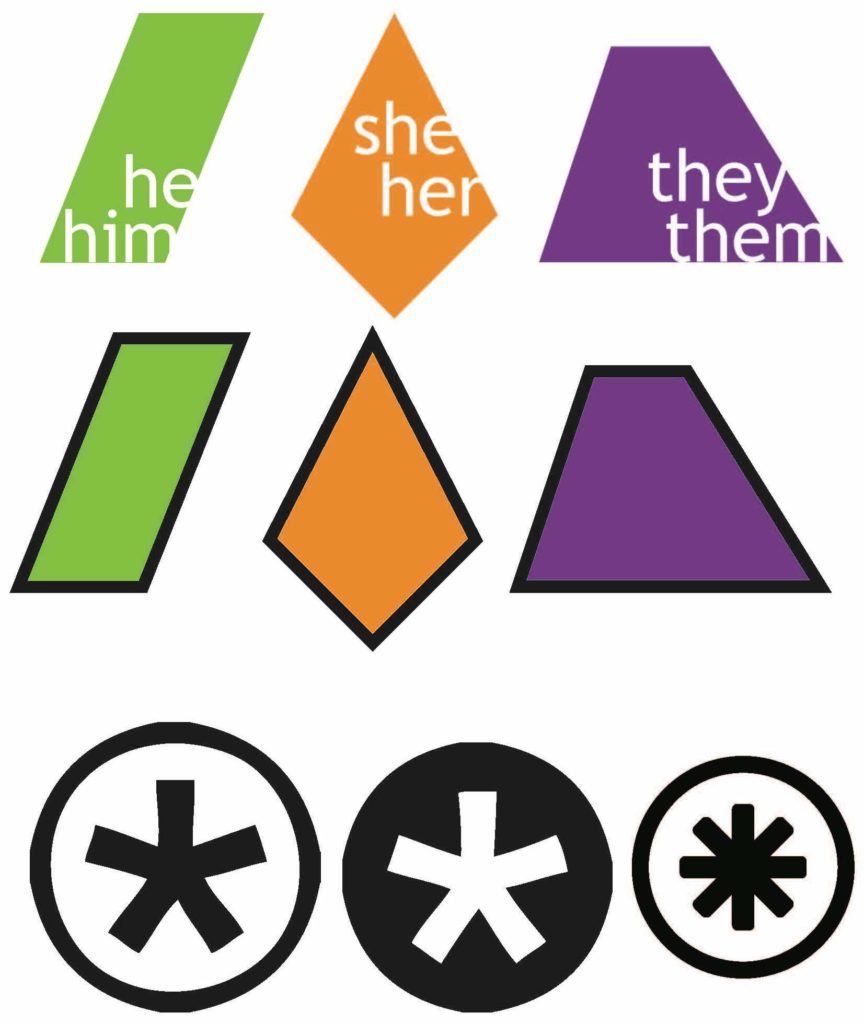 The group discussed text or letters (i.e. an H for he/him, S for she/her, and T for they/them), colors (i.e. identity flags), and various icons (i.e. punctuation marks). There was an initial push to move away from letters or text (given the normativity of English) and toward something like the asterisk. The asterisk (*) symbol has been used by some transgender and gender non-binary communities to signal open possibilities and inclusion. Unfortunately, the asterisk alone did not communicate enough information, specify pronouns, and might be misunderstood as referencing something else (i.e. the FedEx logo is an asterisk). After some conversation, in class and online, the group decided that some sort of shape–iconic and geometric–would make for good pins. The above shapes were possibilities I worked up. We decided to pick shapes that did not have established gendered meanings. We decided to forego colors for the time being, sticking to black outline and white fill mainly because it would limit cost and confusion. And we decided to include the asterisk; though not the focus, the asterisk grounds the pronoun shape and design.
The group discussed text or letters (i.e. an H for he/him, S for she/her, and T for they/them), colors (i.e. identity flags), and various icons (i.e. punctuation marks). There was an initial push to move away from letters or text (given the normativity of English) and toward something like the asterisk. The asterisk (*) symbol has been used by some transgender and gender non-binary communities to signal open possibilities and inclusion. Unfortunately, the asterisk alone did not communicate enough information, specify pronouns, and might be misunderstood as referencing something else (i.e. the FedEx logo is an asterisk). After some conversation, in class and online, the group decided that some sort of shape–iconic and geometric–would make for good pins. The above shapes were possibilities I worked up. We decided to pick shapes that did not have established gendered meanings. We decided to forego colors for the time being, sticking to black outline and white fill mainly because it would limit cost and confusion. And we decided to include the asterisk; though not the focus, the asterisk grounds the pronoun shape and design.
I used Adobe Illustrator to mock up the final shapes, and as a class, we tweaked, revised, and reworked the designs. We picked the right thickness for the lines, the design of the asterisk, the placement of the asterisk, and the proportions and angles of the shape to come up with the end of the line, “Project Asterisk”:
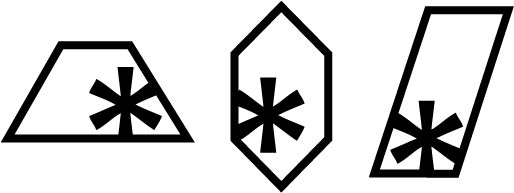 The students then set to work to find and get bids from reputable companies to produce the pins, to develop a expository and training brochure, and to prepare posters and props for the OU Undergraduate Research Symposium.
The students then set to work to find and get bids from reputable companies to produce the pins, to develop a expository and training brochure, and to prepare posters and props for the OU Undergraduate Research Symposium.
“The Pins Are Here!”
Thanks to the speedy responsive of PinDepot.com the pins arrived just in time. The students chose black lines, silver edging, and an enamel white background. I designed the cards for the pins to be mounted on:
With the help of the ARC Assistant, the students created and produced the following posters for their session. The ARC will be part of the Academic Residential Communities and FIG session at the Undergraduate Research Symposium:
- Project Asterisk: The LGBTQIA+ Scholars Academic Residential Community Year-Long Colloquium Project
- Spruce Room: Session 5c
- Josie Fields, Danny Jenkins, Charlie Keene, Haleigh Patten-Trujillo, Rachel Peri, Mathieu Wilson
- Ed Chang (Faculty Mentor)
Here is the promotion and training brochure for “Project Asterisk”:
The students have also drafted a letter introducing the project to university administrators and LGBTQ+ leadership. The letter will be sent along with an archival set of the pins in the hopes that the UO might develop “Project Asterisk” as a campus-wide program. Who knows? Perhaps the project will take off and be used at other institutions across the country or across the world.
All in all, the project has been decidedly a success. The students have reported that while they are wearing their pins, people have been attracted to their design and have been curious about what they mean and what they are for. Visitors to the poster session have also been duly impressed and suggest continuing the project, refining it, in the next year. I am happy that the colloquium and the assignment worked out and worked its magic. And I am proud of the students for their ideas, labor, and investment. In fact, once they saw the actual pins–made, physical, for real–they knew that they had done something unique, something that they will remember for the rest of their careers and lives.
References
Chang, Edmond Y. “LGBTQIA Scholars Colloquium.” Course Website. Autumn Quarter 2016. http://www.edmondchang.com/courses/lgbtqiascholars16f/. Web.
—. “LGBTQIA Scholars Colloquium.” Course Website. Winter Quarter 2017. http://www.edmondchang.com/courses/lgbtqiascholars17w/. Web.
—. “LGBTQIA Scholars Colloquium.” Course Website. Spring Quarter 2017. http://www.edmondchang.com/courses/lgbtqiascholars. Web.
Part Time Rogue. “Dystopia Rising’s Gender Pronoun Patches Promote Inclusiveness In Our Hobby.” Elsewhere Nightly. 8 Jun. 2016. http://elsewherenightly.com/p/dystopia-risings-gender-pronoun-patches-promote-inclusiveness-in-our-hobby/. Web.
Sedgwick, Eve Kosofsky. “Queer and Now.” Tendencies. Durham, NC: Duke University Press, 1993. 1-22. Print.
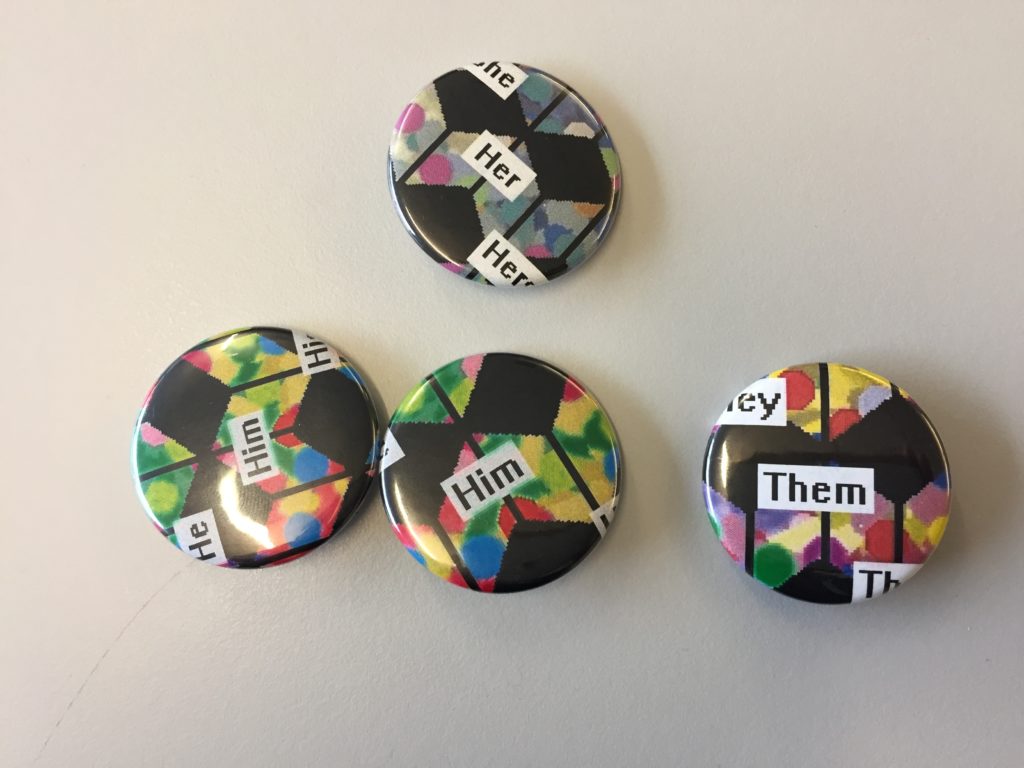
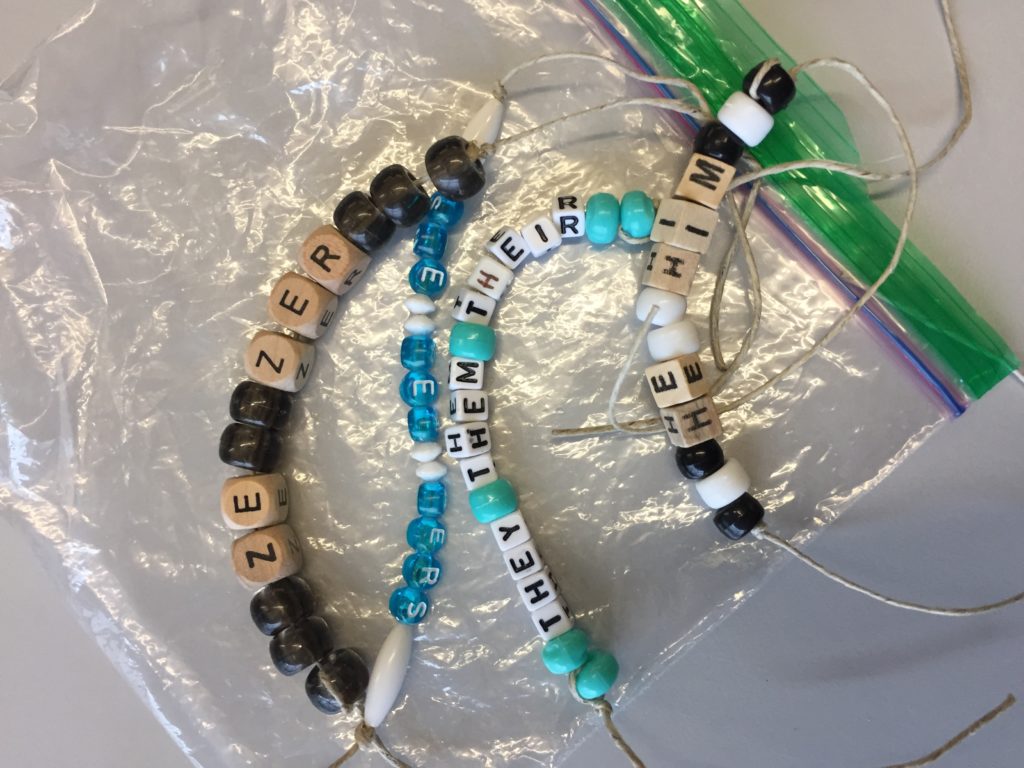
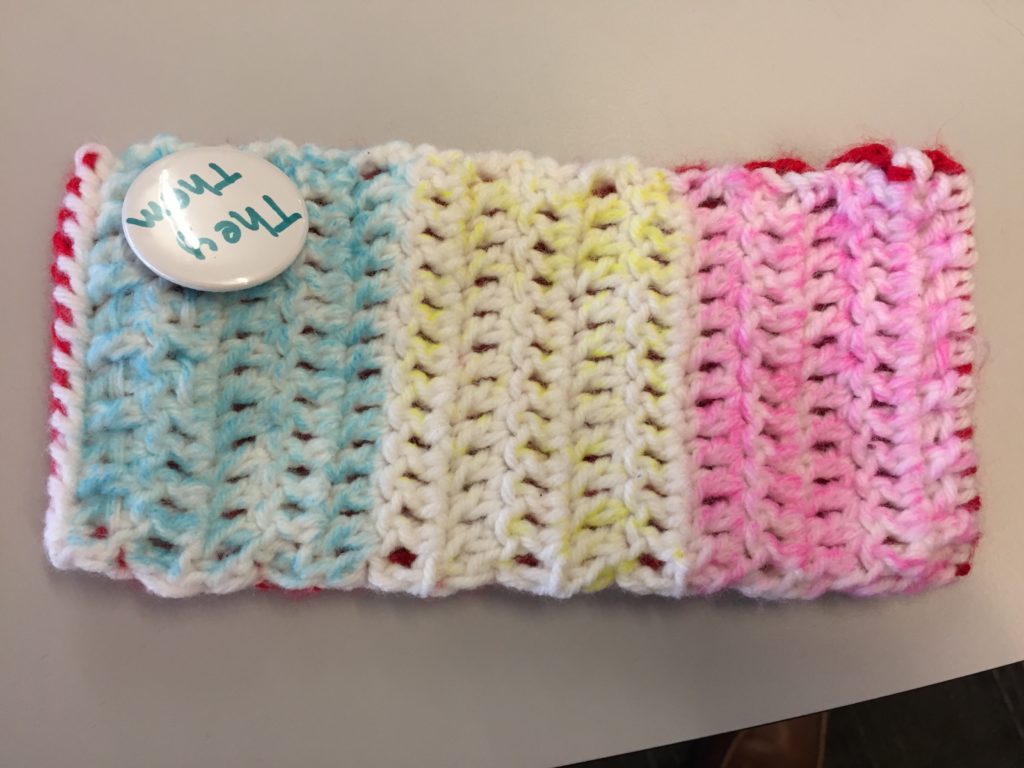
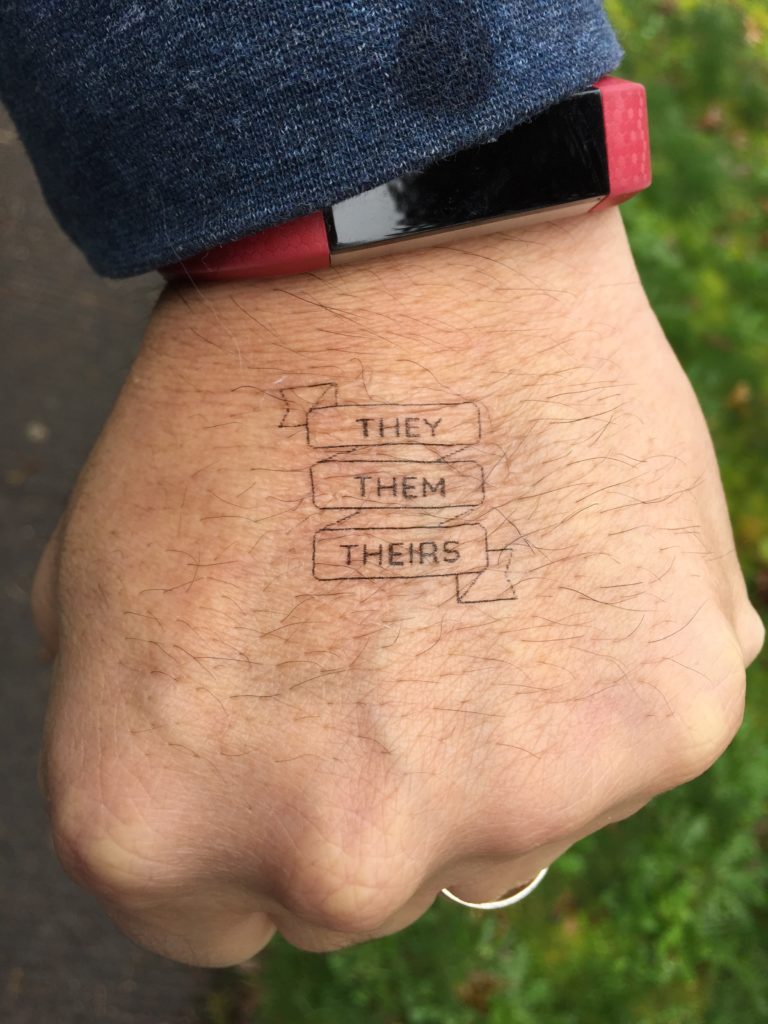
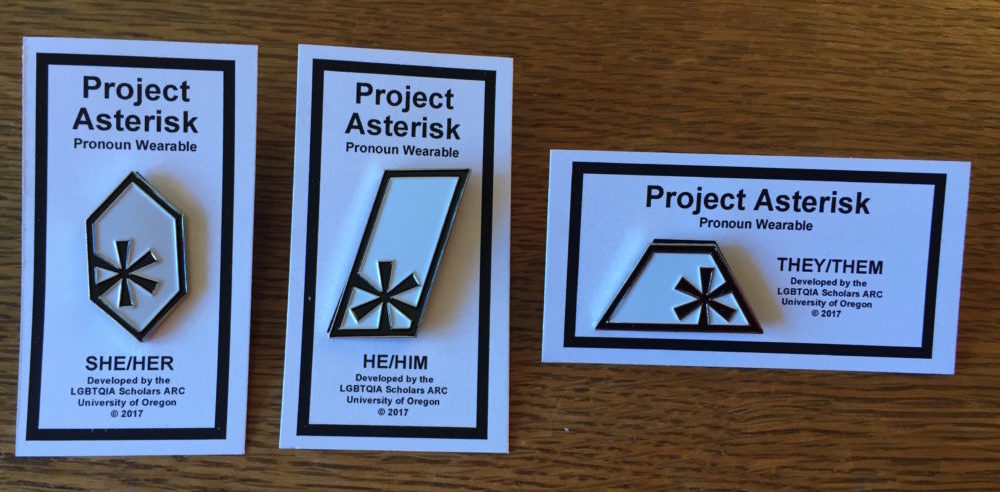
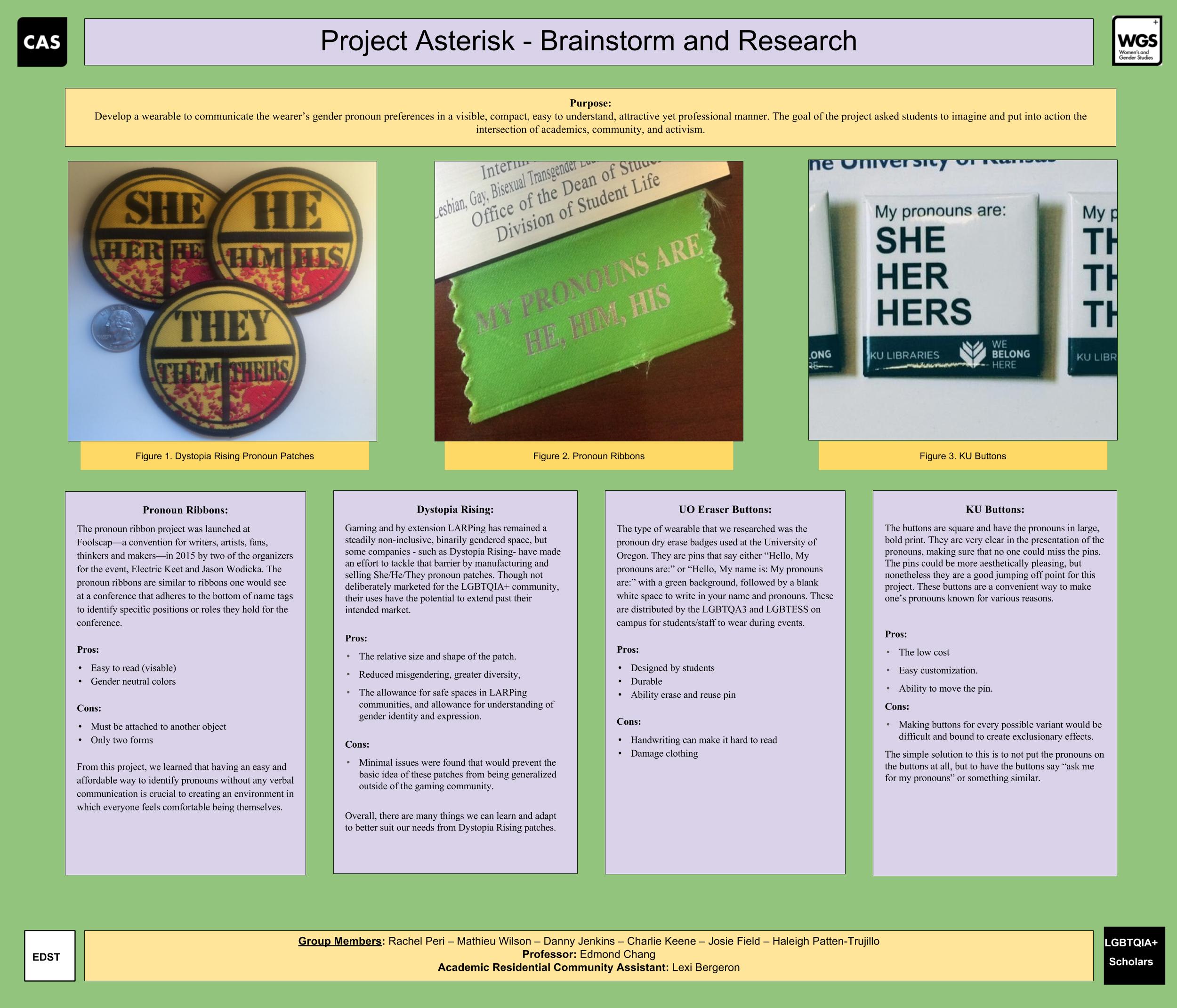
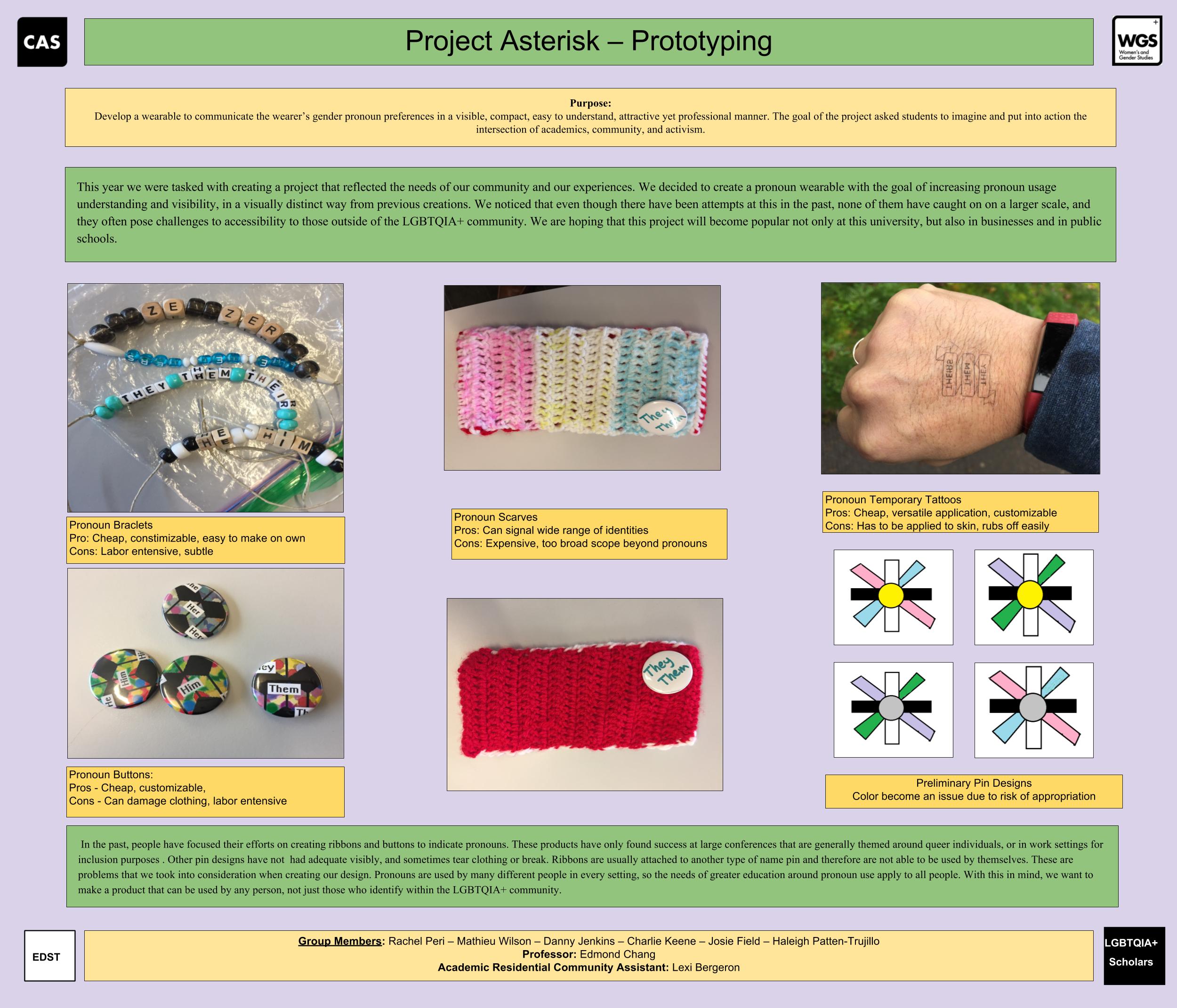
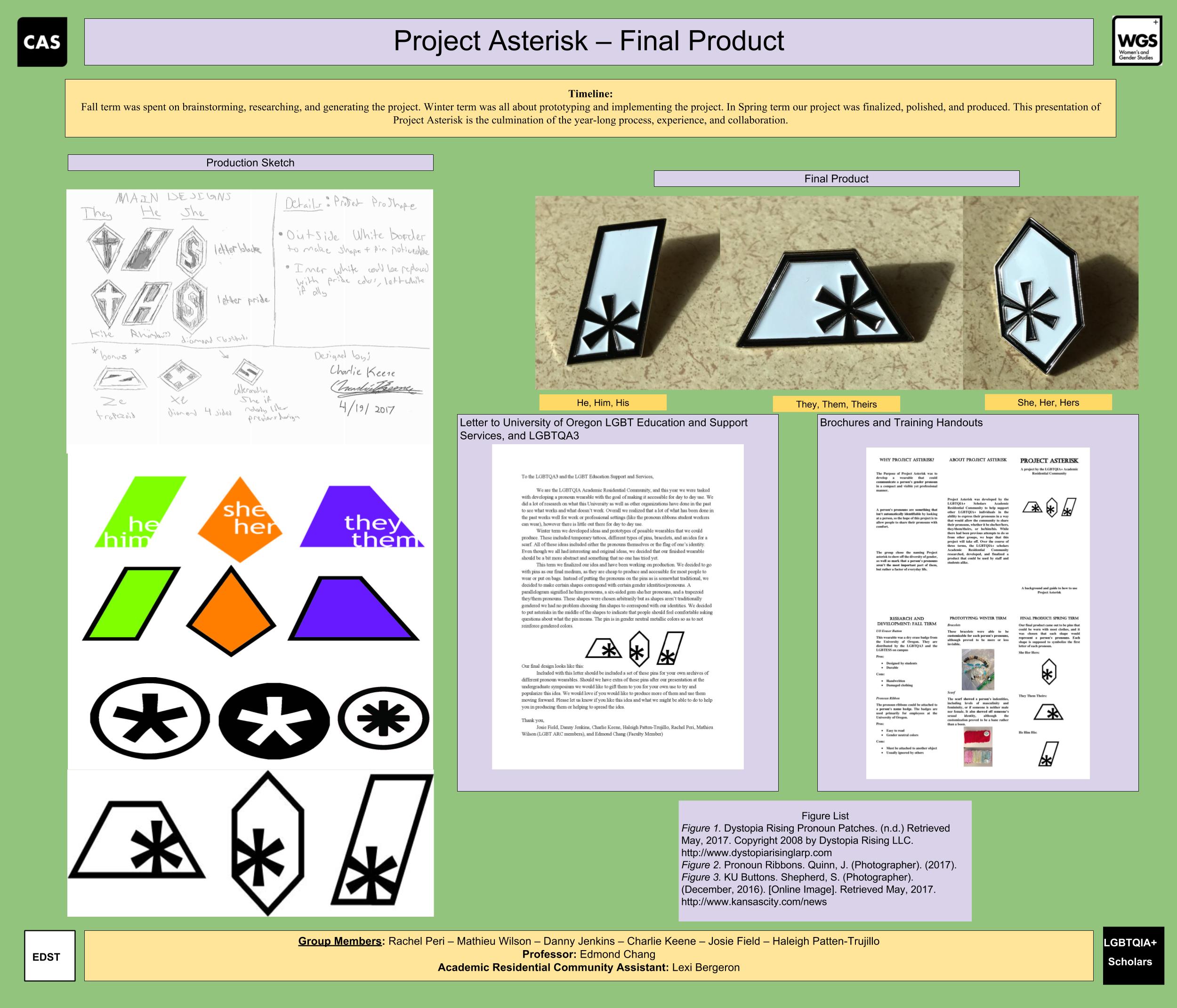
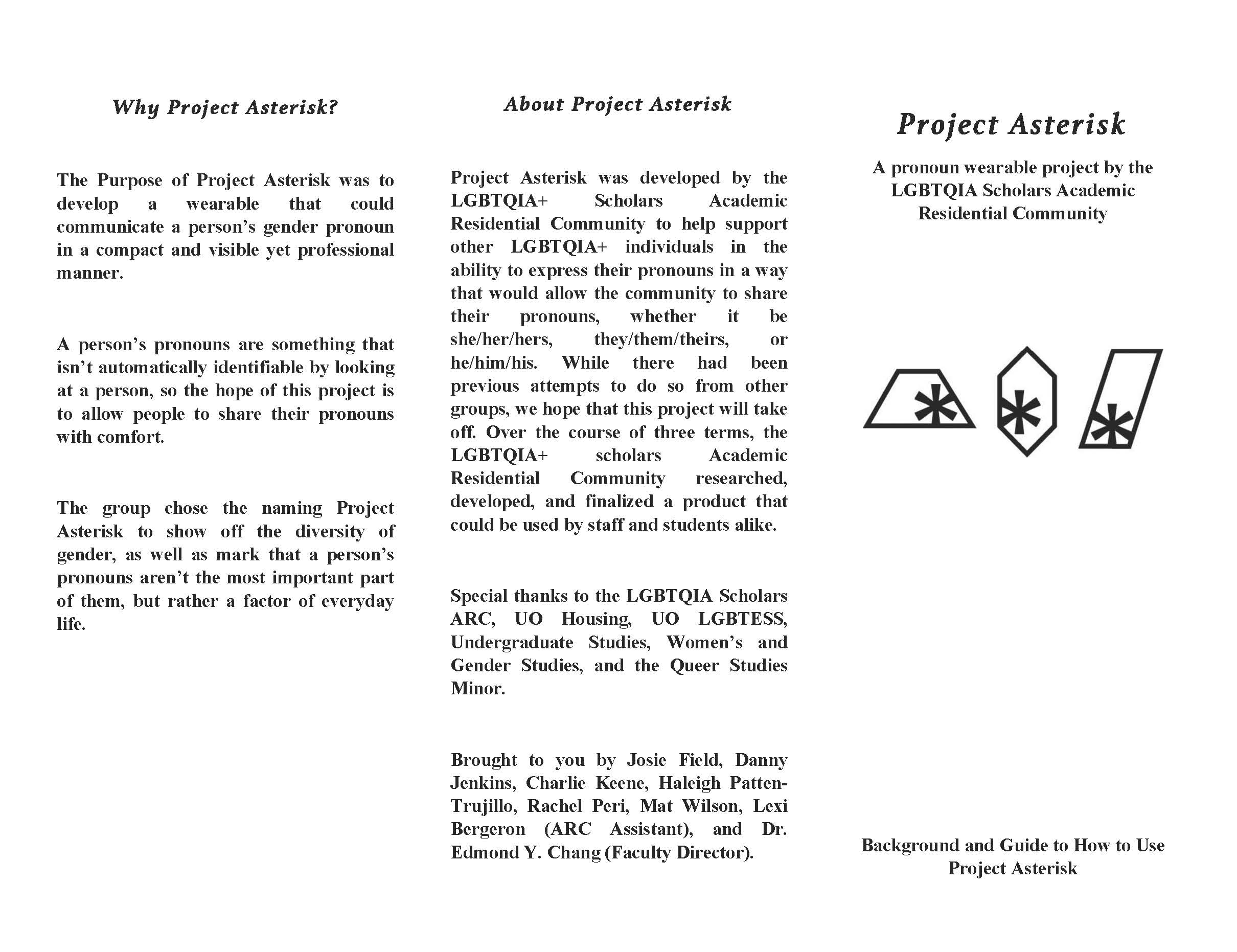
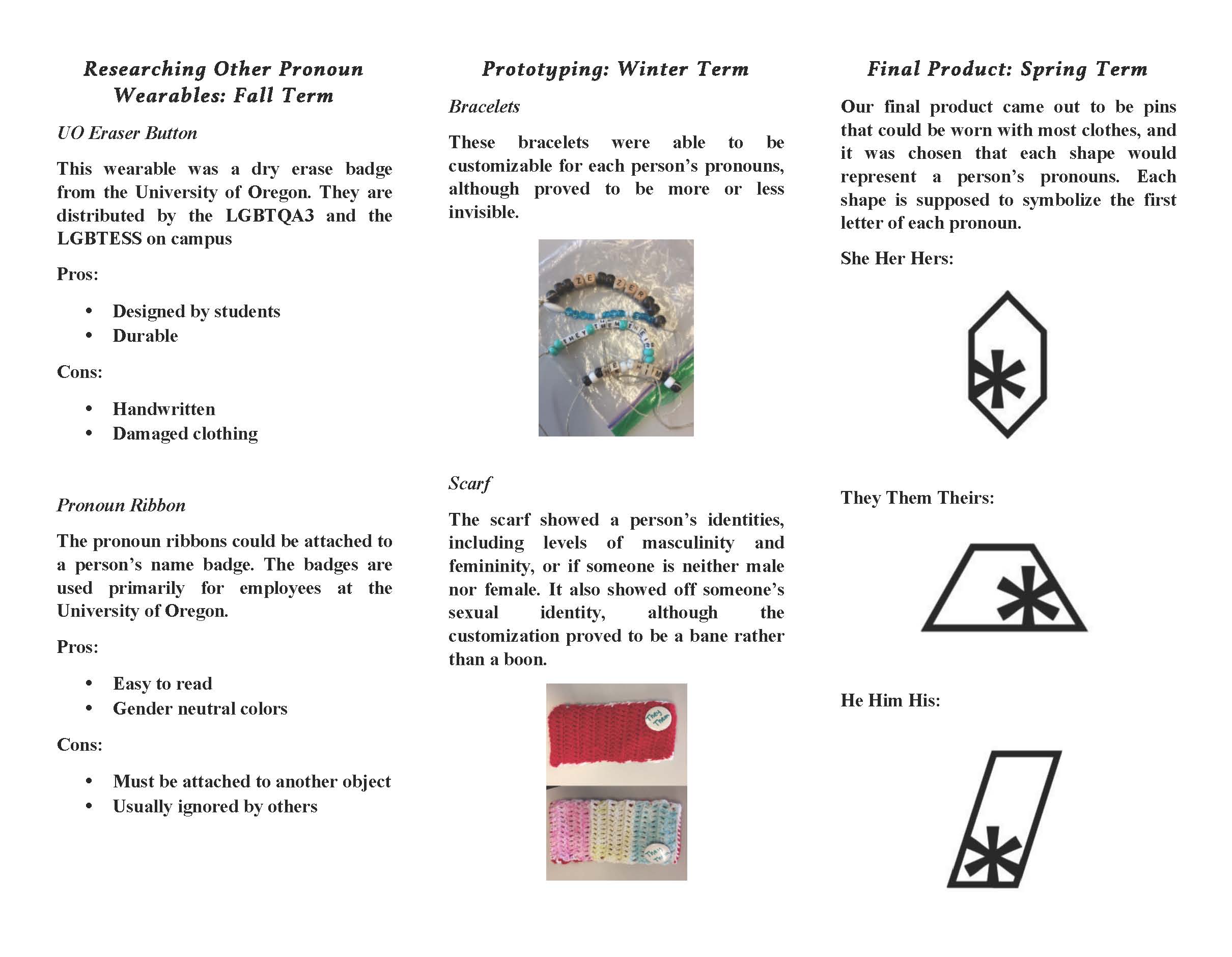
Pingback: “Project Asterisk” Featured Session Video from the 2017 Undergraduate Research Symposium – ED(MOND)CHANG(ED)AGOGY